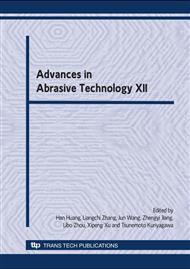p.3
p.9
p.15
p.21
p.27
p.33
p.38
p.43
p.49
Influence of Particle Effects on the Material Removal Rate Utilizing Electrokinetic Phenomenon
Abstract:
With the demand for precise nanometric material removal with minimal defects, several non-contact ultraprecision machining techniques were developed over recent decades. The electrokinetic material removal technique [1] is one such method that allows material to be removed without any physical contact between the tool and the workpiece. In this work, the influence of the slurry mixture on the material removal rate for the electrokinetic material removal process is studied. During the process, it was observed experimentally that the mixture of the slurry affected the material removal rate. The parameters varied in the slurry mixture experiments were the size and concentration of the particles. Explanations for the behaviour of the material removal rate were also suggested during the study to further understand the electrokinetic material removal technique.
Info:
Periodical:
Pages:
27-32
Citation:
Online since:
June 2009
Authors:
Price:
Сopyright:
© 2009 Trans Tech Publications Ltd. All Rights Reserved
Share:
Citation:


